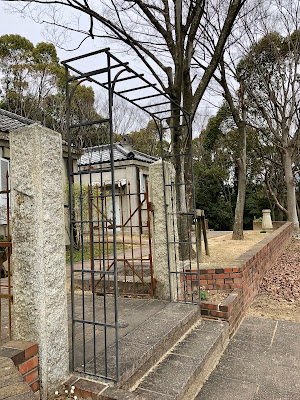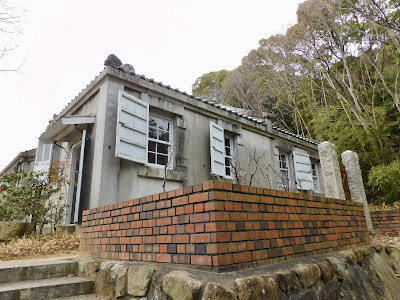 |
| 結婚10周年アートの旅 2023年2月6-12日 2月14日が私達の結婚記念日、私と夫Rは "結婚10周年アートの旅" をしました。 このセクションは主に四国村 (シコクムラ) についてです。 10th Wedding Anniversary Art Trip, 6th of February 6th -12th of February 2023 February 14th was our wedding anniversary, and my husband R and I had a "10th wedding anniversary art trip". This section is mainly about Shikoku Mura. |
 |
| 案内マップ ① - ⑱ の建物を見学しました。(⑪⑯⑰を除く) このセクションは、灯台のエリア: ⑲ - ㉒についてです。 Guide Map We visited buildings ① - ⑱. (Excluding ⑪, ⑯, ⑰) This section is about the lighthouse area : ⑲ - ㉒. 画像は下記より / This from below ★ |
目次/ Contents
1) ⑲大久野島灯台 / Okunoshima Lighthouse
A. '竹林の道' の到着地点
The End Point of the 'Bamboo Path'
B. 灯台 / Lighthouse
C. 錨 / Anchor
2) ⑳江埼灯台退息所
Lighthouse Keeper’s Residence from Esaki
A. 建物 / Building
B. 部屋 / Rooms
3) ㉑鍋島灯台退息所
Lighthouse Keeper’s Residence from Nabeshima Island
A. 鍋島 / Nabeshima Island
B. 台退息所 / Residence
4) ㉒クダコ島灯台退息所
Lighthouse Keeper’s Residence from Kudakoshima Island
A. クダコ島 / Kudakoshima Island
B. 台退息所 / Residence
C. 日時計 / Sundial
D. 別棟 / Bathroom
1) ⑲大久野島灯台
Okunoshima Lighthouse
A. '竹林の道' の到着地点
The end point of the 'Bamboo Path'
 |
| 灯台 灯台を目指して登りの '竹林の道' を歩きました。 灯台が見えてきて、ホッとしました。 Lighthouse We climbed the 'Bamboo Path' towards the lighthouse. I was relieved when I saw the lighthouse. |
 |
| アヤメ 竹林の道の脇に咲くアヤメ (菖蒲/ 文目/ 綾目)? 湿地に生息すると聞くので、山地に咲く、これは アヤメではないかと思います。 Ayame : Iris Sanguinea An Iris Sanguinea flower blooming beside the 'Bamboo Path'? Iris Aevigata (Kakitsubata) live in wetlands, so I think this must be an iris, which grows in mountainous areas. |
⑲大久野島灯台に到着しました。
現在、四国村の最も高い位置に灯台、それに関連する建物が設置されています。
最近ペイントしたばかりなのか、真っ白で美しい灯台でした。
内部も綺麗、掃除が行き届いている印象でした。
四国村は、建物も植栽にも手入れが行き届いていると感じました。
下記、四国村のサイトより引用
"広島県三原近海の航路を照らす灯台としてつくられました。
大久野島 (オオクノシマ/ オオクノジマ)は広島県
忠海町 (タダノウミチョウ) の沖合に浮かぶ周囲4キロの小さな島で、かつては毒ガス製造の島として知られており、軍事拠点として重大な位置を占めていました。
灯台は基礎部分が3.8mの円形で、高さ5.1m直径3.1m。
灯塔部は花崗岩の切石積になっており、その上に乗る塔器は鋳鉄
(ちゅうてつ) 製で高さ2.4mにもなります。"
私は、灯台そのものが好きです。
灯台には、物語を感じますし、現実的な役割も、精神的に比喩に用いられる場合も、好ましいです。
 |
⑲大久野島灯台(オオクノシマトウダイ) ⑲Okunoshima Lighthouse Okunoshima ; Ōkunoshima Island is a small island in the Inland Sea of Japan. |
Lighthouse
We arrived at the ⑲Okunoshima Lighthouse.
Today, the lighthouse and related buildings stand at the highest point in Shikoku Mura.
The lighthouse was pure white and beautiful, as if it had been painted recently.
The interior was also clean and seemed well-maintained.
At Shikokumura, I felt that both the buildings and the plants were well-maintained.
According to Shikoku Mura website about Okunoshima Lighthouse,
"This lighthouse was built to guide the way along the sea route passing near Mihara, Hiroshima Prefecture.
Okunoshima (Ōkunoshima) is a small island, just four kilometers around, out in the sea off Tadanoumi town in Hiroshima Prefecture.
It was once a critical military base, and was used for poison gas production.
The round lighthouse has a 3.8m base.
It rises 5.1 meters high and is 3.1 meters across.
The tower section is made of hewn granite blocks, and the cast iron cupola on top stands 2.4 meters high.
I like lighthouses themselves.
They have a story to tell and I like their practical role as well as their spiritual metaphorical role.
 |
⑲大久野島灯台 ⑲Okunoshima Lighthouse According to Shikoku Mura website. about Okunoshima Island, "During the war, this island had a military base producing poison gas, and so it was erased from the maps. Now, it is a popular tourist spot because of its large population of wild rabbits." 赤い丸 : 大久野島 Red Circle : Okunoshima Island |
 |
| 瀬戸内海周辺・英語版 Around Seto Inland Sea 画像は下記より / This from below ★ |
 |
| 2代目、大久野島の灯台 1998年竣工 / 撮影2018 1代目の灯台(⑲)が四国村に移設された後、 2代目灯台が設置されています。 Second Okunoshima Lighthouse Completed in 1998 / Photographed in 2018 The second lighthouse was built after the first lighthouse (⑲) was moved to Shikokumura. 画像は下記より / This from below★ |
下記、四国村ブログより
"この灯台 (⑲) が建築されたのは1889年 (明治26年) で、明治政府おかかえ (お雇い外国人) の英国人技師たちが設計から建築、運営に携わっていたころの話です。
そして、灯台の他にも「退息所」と呼ばれる灯台職員が暮らした住居が3棟並んでいます。
淡路島の⑳江埼灯台退息所 (明治4年建築)、
坂出の㉑鍋島灯台退息所 (明治6年建築)、
愛媛の㉒クダコ灯台退息所 (明治36年) で、
灯台技術導入時に英国人たちが暮らした洋風建築から、日本人も技術を取得して和洋折衷の建物に変遷していく歴史が感じられます。"
According to Blog of Shikoku Mura, only Japanese (translated by me)
"This lighthouse (⑲) was built in 1889, a time when British engineers working for the Meiji government were involved in everything from design to construction and operation.
In addition to the lighthouse, there are three residences called 'residences' where lighthouse staff lived.
The ⑳Esaki Lighthouse Residence on Awaji Island (built in 1871),
the ㉑Nabeshima Lighthouse Residence in Sakaide (built in 1873), and
the ㉒Kudako Lighthouse Residence in Ehime (1903)
show the history of the buildings moving from Western-style buildings where the British lived when lighthouse technology was introduced, to Japanese people acquiring technology and becoming a hybrid of Japanese and Western styles."
C. 錨 / Anchor
2) ⑳江埼灯台退息所
Lighthouse Keeper’s Residence from Esaki
A. 建物 / Building
 |
⑳江埼灯台退息所 退息所とは、灯台もりの住居です。 "壁は、奥行き60cmほどの花崗岩の切り石を 積み上げてつくられています。" (四国村のサイトより) ⑳Lighthouse Keeper’s Residence from Esaki According to Shikoku Mura website "The walls are built of hewn granite blocks some 60 centimeters thick." |
下記、四国村のサイトより引用
"淡路島の北端にあった江埼灯台はイギリス人技師のブラントンの設計によりつくられ、わが国で8番目に点灯された洋式灯台です。
灯台守たちが暮らした退息所は、花崗岩の切り石を積み上げて建築した重厚な印象の洋風建物となっています。
平成7年(1995)の阪神・淡路大震災により石造の壁に大きな亀裂が入り屋根瓦が落下するなど甚大な被害をこうむったため、四国村に
移築復原されることになりました。"
 |
⑳江崎灯台退息所 "建築当初の伝統的な木組である木造トラスが残っているなど、 洋式灯台の黎明期を知ることができる貴重な建物です。" (四国村のサイトより) ⑳Lighthouse Keeper’s Residence from Esaki According to Shikoku Mura website "Elements like traditional wooden trusses used when the lighthouse was first built are still in place, making this building a valuable reminder of the early days of Western-style lighthouses." 画像は下記より / This frombelow★ |
The Esaki Lighthouse, found at the northern tip of Awaji Island, was the eighth such one in Japan designed and built by British lighthouse planner R. H. Brunton.
The Western-style building served as living quarters for the lighthouse keepers, and owes its imposing presence to the hewn granite block construction.
The 1995 Great Hanshin Earthquake caused extensive damage, including severe cracks in the stone walls and fallen roof tiles.
It was then moved to Shikoku Mura and restored."
 |
| 江崎灯台 初点灯 : 1871 (明治4年) 淡路島 / 撮影:2011 設計: リチャード・ヘンリー・ブラントン(1841 -1901) Esaki Lighthouse First Lit : 1871 Awajishima Island, Hyogo prefecture, Japan. Photography in 2011 It was constructed by Richard Henry Brunton (1841 -1901).  江崎灯台 撮影:2011 Esaki Lighthouse Photography in 2011 画像は下記より / These from below ★ |
 |
| リチャード・ヘンリー・ブラントン (1841 -1901) 下記、Wikiより "リチャード・ヘンリー・ブラントンは、イギリスの スコットランド出身の土木技術者で、明治政府に 灯台建設主任技術者として雇われ、 明治初期の灯台建設を指揮した。 勤務していた7年6ヶ月の間に灯台26、 灯竿(トウカン)5(根室、石巻、青森、横浜西波止場2)、 灯船(トウセン)2(横浜港、函館港)などを設計した。 このため「日本の灯台の父」と讃えられている。 Richard Henry Brunton (1841 - 1901) |
According to Wiki about Richard Henry Brunton
"Richard Henry Brunton FRGS MICE (26 December 1841 - 24 April 1901) was a British engineer known as the 'Father of Japanese lighthouses'.
Brunton was born in Muchalls, Kincardineshire, Scotland.
He was employed by the government of Meiji period Japan as a foreign advisor (o-yatoi gaikokujin), primarily to build lighthouses.
Over a period of seven and a half years he designed and supervised the building of 26 Japanese lighthouses in the Western style, which became known as Brunton's 'children'. "
B. 部屋 / Rooms
灯台守たちが暮らした退息所は、なかなか、立派な調度が揃えられています。
当時の日本の家屋の中では、豪華なのではないでしょうか?
まあ、外国人の灯台守のためなので、特別な扱いだったのでしょう。
灯台守の技術を学ぶために、日本人の灯台守も一緒に過ごしていたか、私には分かりませんし、四国村のサイトにもそれは説明されていません。
Rooms
The house where the lighthouse keepers lived was quite well furnished.
It must have been quite luxurious compared to other Japanese homes of that time, mustn't it?
Well, I guess it was special treatment since it was for foreign lighthouse keeper(s).
I don't know if Japanese lighthouse keepers were spending time with them to learn lighthouse keeping techniques, and the Shikokumura website doesn't explain this.
3) ㉑鍋島灯台退息所
Lighthouse Keeper’s Residence
from Nabeshima Island
A. 鍋島 / Nabeshima Island
 |
| 赤丸 : 鍋島 香川県坂出市与島町鍋島 Red Circle : Nabeshima Island Nabeshima, Yoshimacho, Sakaide City, Kagawa Prefecture |
 |
| Red Kanji : Nameshima Island Grey Line : Great Seto Bridge 画像は下記より / This from below ★ |
 |
| 鍋島灯台 / Nabeshima Island Lighthouse 画像は下記より / This from below ★ |
B. 台退息所 / Residence
 |
㉑鍋島灯台退息所 竣工:1873年(明治6年) 屋根は瓦葺きで和風、円柱6本は洋風の和洋折衷の建物です。 下記、文化庁サイトより "もと香川県坂出市与島町鍋島に所在。 神戸・長崎間航路にあたる瀬戸内海の小島に築造された 四等灯台の外国人灯台守用の宿舎。 ブラントンの指導によるものとされ、石造平屋建、寄棟造、桟瓦葺 で、正面全面に素朴なトスカナ式列柱によるベランダを付ける。" ㉑Lighthouse Keeper’s Residence from Nabeshima Island 画像は下記より / This from below |
下記、四国村サイトより
"香川県坂出市の沖にある与島に隣接する小さな島、鍋島に設置されていた洋式の灯台守の住居。
イギリス人技師・ブラントンによって設計されました。
'退息所' とは灯台守の住宅で、明治6年 (1873) の竣工から昭和30年 (1955) 頃まで、約80年以上にわたって宿舎として使用されたあとは海上保安本部の通信施設となっていました。
壁は与島産の花崗岩の切石を積み上げてつくられており、重厚な石造りの建物となっています。"
According to Shikoku Mura Website,
"This Western-style lighthouse keeper’s residence was built on Nabeshima, a small island next to Yoshima Island off the coast of Sakaide, Kagawa Prefecture.
British architect R. H. Brunton designed it. Keepers used it as a residence, as well as for work and storage, for more than 80 years, from its completion in 1873 until 1955.
It was then converted into a communications facility for the Japan Coast Guard Main Office. The walls are built from granite mined on Yoshima, giving it an imposing aura."
4) ㉒クダコ灯台退息所
Lighthouse Keeper’s Residence
from Kudakoshima Island
A. クダコ島 / Kudakoshima Island
 |
| クダコ島 / Kudakoshima Island 画像は下記より / This from below ★ |
下記、サイト:'里島(リトウ)めぐり'からの引用。
「クダコ島」は、東西に幅約0.6海里・最大水深154mの
水道 (水路) 中心にあります。
~~~
頂上の地形を巧みに利用した城郭は、南側の絶壁は自然の城壁となり、まるで島全体が城塞であったかのようです。
~~~~
クダコ水道の要衝にありましたが、1585年の
その後、江戸時代には草刈り・採藻の入会地となりました。
この島を拠点にしていた忽那水軍の呼び名から「クダコ」と呼ばれ、忽那家文章には『久田子衆』や『九多児衆』と書かれています。"
 |
| 赤丸 : クダコ島 Red Circle : Kudakoshima Island |
Kudakoshima Island
According to the website: 'Ritou Tour' only in Japanese (translated by me)
"Kudakoshima Island, an isolated island with a circumference of 1.8 km, lies between Nakajima Island and Nuwa Island, and is located in the centre of a strait that is about 0.6 nautical miles wide from east to west and 154m deep at its deepest.
~~~
The castle, which makes clever use of the topography of the mountain, has a natural wall on the cliff on the south side, making it seem as if the entire island was a fortress.
~~~
It was located at a strategic point on the Kudako waterway, but its naval functions seem to have come to an end with the downfall of the Kutsuna Navy in 1585.
Later, during the Edo period, it became a common area for cutting grass and gathering seaweed.
It was called "Kudako" after the name of the Kutsuna Navy ~~".
B. 台退息所 / Residence
"愛媛県松山市沖のクダコ島にあった灯台退息所です。
レンガ造りで、外壁がモルタル仕上げとなっています。
屋根は桟瓦葺き(※1)。
注1(※1):桟瓦葺き・・・平瓦と丸瓦を一体化させた波型の桟瓦を使用した屋根の葺き方。"
According to Shikoku Mura Website,
"This lighthouse keeper’s quarters was once on Kudakoshima Island, which is in the sea off the coast of Matsuyama, Ehime Prefecture.
It is constructed of brick with stucco finishing on the exterior walls.
The roof is in the sangawara-buki style (*1).
*1: Sangawara-buki—A roof covered with tiles that combine flat and round tile parts in a wave shape."
 |
| 無線送信機 下記、四国村のサイトより引用 "灯台と退息所との間では無線の通信が使われていました。 玄関の斜め上部にある金属製の装置は、 退息所側の受信機器の一部です。" Wireless Transmitter According to Shikoku Mura Website, "The lighthouse and quarters could communicate wirelessly. The metal equipment found above and to the side of the entryway is part of the quarters’ receiver setup." |
 |
 |
| 入り口前の池 この池(?)は、瀬戸内海を模し、 石は、忽那諸島 (クツナショトウ)を表現しているのでしょうか? Pond in Front of the Entrance This pond(?) is modeled after the Seto Inland Sea, and the stones represent the Kutsuna Islands? |
下記、四国村のサイトより引用
"押入れのついた畳部屋を中心に左右対称の間取りになっています。
明治後期の建築で、この頃には灯台守も日本人となっていたのでしょう。
洋式灯台初期のものとは異なる点が見受けられ、灯台建築の変遷が分かる貴重な資料です。"
According to Shikoku Mura Website,
"The floor plan is symmetrical, centering on a tatami-mat room with a closet. As an example of late-Meiji architecture, it shows how more lighthouse keepers were Japanese.
It demonstrates differences from the earlier Western-style lighthouse style, making it a valuable testament to evolution in the art."
 |
| 窓が凝った作りになっていると思いました。 I thought the windows were elaborately designed. |
By the way, the Japan Maritime Self-Defense Force had a minesweeper called "Kudako" (MSC-622, YAS-74), named after Kudakoshima Island.
B. 日時計 / Sundial
 |
| The guide board says, "The sundial was relocated along with the front gate as part of the Kudakoshima Island Lighthouse residence facilities." |
 |
| 表門 ゲートを通ると見晴台のような場所が設けられ、 そこには日時計があります。 Front Gate Once you pass through the gate, you'll come to an observation deck-like area with a sundial. |
 |
| ゲート脇の花 Flowers by the Gate |
 |
| 日時計 日時計であったというべき? Sundial Should I say it had been a sundial? |
 |
| 鳥の声を聞く 鳥の声を聞き、見上げるとこの子がいました。 どの種類の鳥なのか? ヤマガラでしょうか? Listen to a Bird Song I heard a bird singing and looked up and there this was. Which kind of bird is this? Is it a varied tit? |
C. 別棟 / Bathroom
 |
| ㉒クダコ島灯台退息所 別棟 ここは、灯台エリアの東端になります。 ㉒ Bathroom, Lighthouse Keeper’s Residence from Kudakoshima Island This is at eastern end of the lighthouse area. |
このエリアを離れ、'見晴らし坂' を降りてゆきました。
We left this area and headed down 'Observation Hill : Miharashi-zaka'.


.jpeg)


.jpeg)





















0 件のコメント:
コメントを投稿